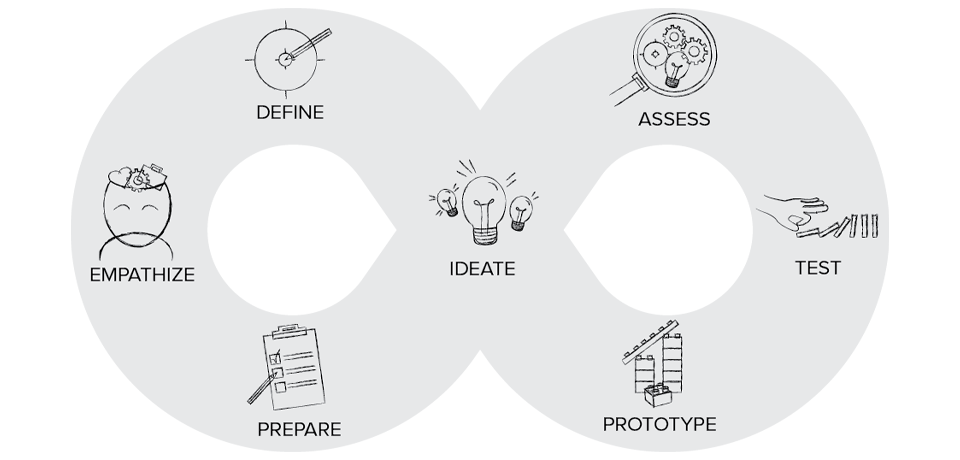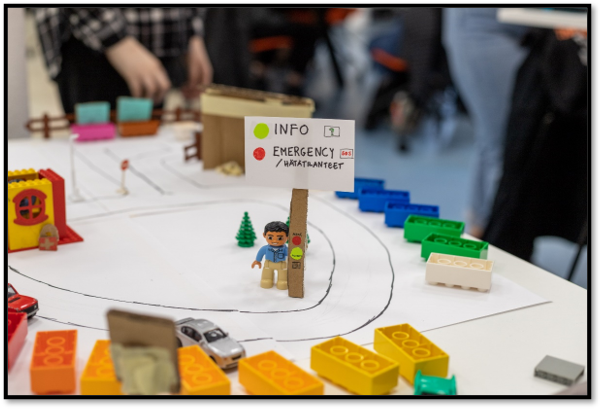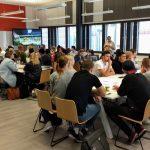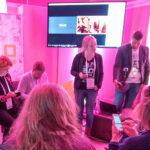
Jari Jussila, Jukka Raitanen & Vesa Tuomela
Design thinking is an approach to exploring and solving problems through collaboration and creative methods. Importantly, design thinking is not a linear approach, but a way to solve challenges iteratively, repeating necessary design thinking process phases until satisfactory results are achieved (Jussila et al., 2020). The Design thinking process is applied in most of the student projects done for industry in HAMK Design Factory. Therefore, we have found it important to describe how design thinking is perceived in HAMK Design Factory and elaborate our current thinking about it.
One of our first attempts to describe the design process followed the process guide to design thinking introduced by Hasso Plattner Institute of Design at Stanford (d.school, 2010), and focused on describing the five phases of empathize, define, ideate, prototype, and test in the design thinking process (Figure 1). This version of the design thinking process was first applied in Smart Design Project in 2019, where students from Mechanical Engineering and Product Technology, Construction Engineering, Electrical and Automation Engineering, and Computer Applications Degree Programmes created prototypes of solutions for industry in interdisciplinary teams.
The challenge with this illustration is that it gives an impression of a linear process, where you execute each phase, and then you are done. This contrasts with the iterative nature of the design thinking process, and people may question why on earth the whole process or certain phases should be repeated if they are completed once already. Furthermore, this illustration does not explain what you miss if you fail to complete one phase of the design thinking process, for example, the test phase.
A more detailed design thinking process model introduced by Interaction Design Foundation (Dam, 2022) highlights that design thinking is a non-linear process and has feedback loops between the different design thinking process phases. This means that at certain points during the process you may need to go back, for example, in testing the prototype you may gain new user insights that lead to redefining the problem and ideating a solution to the redefined problem, creating a new prototype, and testing it with users. We have in practice recognized this need to iterate the design thinking process phases in several Design Factory projects (Lahdenperä et al., 2022) and therefore have found it important to introduce the illustration of a non-linear design thinking process to students (Figure 2).
In practice, we have observed that it is not enough to know and be able to describe and theoretically understand five design thinking process phases and the non-linear and iterative nature of the design thinking process—what is needed is also design doing. Only by actually doing the design thinking process phases, they become clearer. One example of applying this non-linear design thinking process took place during one-week-long Design Sprint and 15-week-long Product Development Project that followed the Design Sprint. The Design Sprint was organized from 1st October to 5th October 2021. The Design Sprint challenges were given by the City of Helsinki, Climate Upper Secondary Schools, Kausal Oy, and Kiertokapula Oy. Students from Sustainable Development, Bioeconomy Engineering and Forssa Vocational Institute formed interdisciplinary teams and created solution prototypes for the challenges in one week. During the week, one team created a prototype for improved user experience at Kiertokapula Karanoja waste treatment site (Figure 3). This prototype was tested with Kiertokapula representatives during the week, and the students received feedback that helped them to learn more about the problem space and main user pain points recognized by the company representatives. This feedback served as the starting point of the second iteration of the design thinking process, which lasted the next seven weeks of the Product Development Project course.

Some students who completed the one-week-long Design Sprint and seven-week-long Product Development Project that followed were wondering why another iteration of the design thinking process is necessary in an eight-week-long Product Development Project that followed the first two iterations. This can be difficult to perceive beforehand, but after doing the third iteration, it was clear that several of the solution prototypes were significantly improved, and doing the iterations made sense retrospectively.
While making several projects where the design thinking process has been applied, we have recognized that in some situations it is helpful to introduce some additional phases, such as, prepare and assess (Kunnari et al., 2019; Raitanen & Tuomela, 2020) to ensure a more successful implementation of the process. Prepare phase helps to orient the students into design thinking (Jussila et al., 2020), and demonstrating examples from previous projects, where several iterations of the design thinking process have been done can help to understand what the benefits of a non-linear process are and why it is necessary when dealing with complex and ill-defined problems. The additional assess phase after the test phase emphasizes that the feedback received from testing should be used to improve the next iteration of the solution and that giving and receiving feedback is an important phase of learning in the process (Raitanen & Tuomela, 2020). Putting these insights together, the design thinking process can be also visualized as a loop (Figure 4).
The loop begins with prepare (Raitanen & Tuomela, 2020; Jussila et al., 2020), going from empathize, define, ideate, prototype, test to assess what has been achieved, and then back to necessary phases that need to be repeated in a loop that keeps going on until satisfactory results are achieved. Time and new experiments will tell whether we have achieved in this presentation to introduce the design thinking processes in a more easily comprehensible way. Please go ahead and try it out—and return to us with feedback if you find it useful.
Authors
Jari Jussila, D.Sc. (Tech.), is Director of HAMK Design Factory. Jari Jussila has been co-creating interdisciplinary learning experiences in HAMK Design Factory and School of Entrepreneurship and Business at Häme University of Applied Sciences.
Jukka Raitanen, (MBA), Business and Service Design teacher at Häme University of Applied Sciences. Raitanen has been creating new interdisciplinary learning communities as a member of HAMK Entrepreneurial university and HAMK Design Factory.
Vesa Tuomela, MSc (Econ.), MBA, teacher in business design at Häme University of Applied Sciences.
References
Dam, R. F. (2022). The 5 Stages in the Design Thinking Process. Retrieved June 9, 2022, from https://www.interaction-design.org/literature/article/5-stages-in-the-design-thinking-process
d.school. (2010). An introduction to Design Thinking. PROCESS GUIDE. https://s3-eu-west-1.amazonaws.com/ih-materials/uploads/Introduction-to-design-thinking.pdf
Jussila, J., Raitanen, J., Partanen, A., Tuomela, V., Siipola, V., & Kunnari, I. (2020). Rapid product development in university-industry collaboration: Case study of a smart design project. Technology Innovation Management Review, 10(3).
Kunnari, I., Jussila, J., Tuomela, V., & Raitanen, J. (2019). Co-creation pedagogy from cSchool towards HAMK Design Factory. HAMK Unlimited Journal, 31.10.2019. https://urn.fi/URN:NBN:fi-fe2020111390342
Lahdenperä, J., Jussila, J., Järvenpää, A. M., & Postareff, L. (2022). Design Factory–Supporting technology students’ learning of general competences through university-industry collaboration. LUMAT: International Journal on Math, Science and Technology Education, 10(1), 127–150.
Mikkonen, M. & Jussila, J. (2022). Introduction to prototyping. Retrieved June 10, 2022, from https://www.slideshare.net/hamkdf/freezing-week-2022-introduction-to-prototyping
Raitanen, J. & Tuomela, V. (2020). Muotoiluajattelun hyödyntäminen liiketoiminnan kehittämisessä. HAMK Unlimited Professional, 17.12.2020. https://urn.fi/URN:NBN:fi-fe2020120499532





